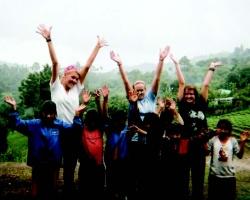We drive for an hour or more in a beatup minivan, inching past multicolored buses, Mayan women carrying loaded baskets, children and skinny dogs. Painted signs assault us—ads for Coke, cell phones, Burger King. I take it all in as my students retell the same jokes and stories. I see trees on the hills and clouds rise above the volcanoes. The natives have incredibly black hair, wide cheekbones and smooth, brown skin.
Just as I start to challenge the students to stop talking and notice their surroundings, the van stops. They spill out, immediately diving into village life, saying, “Hola,” to everyone and greeting every child by name. I realize they have been paying attention.
All in a Day’s Work
As we walk into the village, we slip and stumble in the mud. We pause at the doorway of the home where we are to work. Actually, it’s a shack. Trash rings the walls. Two tiny cats mew, their hair matted and eyes gummed with dirt and disease. Chickens scratch the ground and a duck waddles up with six incongruously soft, clean yellow ducklings. A bull is hitched to a post, dropping feces and urine. Children are everywhere, running in and out of rooms, up and down paths, grabbing our hands. I am not that bothered by the filth; but I shudder that these children live in squalor.
In the midst of this, the team leader—a quiet, hardworking Guatemalan named Hector—leads us in building an additional room. We are tearing out existing walls made of cornstalks, replacing them with a sheet of corrugated metal. Still substandard, there is no insulation, and water and mud still can seep in at the bottom. The tools are few and basic: two hammers, a shovel and measuring tape, tin snips, a T-square, level and post-hold digger.
Spreading the Good News
There is not enough space or tools for everyone to work. So the girls from our youth group take the children to play. They start with simple games—jump rope, duck duck goose (pato pato gonzo), tag. The children giggle and play with abandon, and our students sing the two Spanish songs they know.
Slowly, other children arrive. I am never quite sure how that happens. It’s not as if kitchen phones start ringing through the village! Yet news spreads fast that gringos are here. By the time we leave at mid-afternoon, 25 to 30 children are gathered. Young mothers, the same age as my students, stand to the side watching, babies on their hips.
Games continue and laughter rings through the heavy rain. As we slip and slide in the mud, the children are unfazed. We try to avoid the puddles, while the Mayan children stomp through without breaking stride. They are blissfully unaware of the cold, wet and filth around them.
Taste and See
We are called to lunch inside the home. The mother has cooked all morning over an open fire, making tortillas and rice for us in gratitude. We are shamed. Though we left much of our affluence behind to come here, it tags along in our thoughts, rain jackets, running shoes and orthodontic devices. Every set of eyes in the home are on us, looking to see if we like the food. I want to hand my bowl back and say, “No! You! Please eat this. I have had three square meals every single day of my life,” but I do not. To reject their generosity would be rude.
Hector tells us more about the children. José is 12, though he is the size of an American 8-year-old. His dad is not around. José loves to work with Hector. He is talented and learns quickly. José’s mother asked Hector to take José to live with him because his life would be better. Hector wants to find a way for José to get out of the village, but he knows he cannot accept that responsibility.
We hear about other children and their needs. We lay hands on a girl who has seizures. We pray wimpy, baffled prayers. Then Hector prays, his words flowing in a torrent. He prays for the children, healing, truth, protection. He repents on behalf of the village, still trapped in ancient folk religions. He prays the people will stop offering animal sacrifices to their animistic god. It moves me to hear him, like Jesus weeping over Jerusalem.
We say, “Amen,” and lift our heads. The girl, only 8 or 9, has been crying—not little girl tears, but big heaving sobs. It feels like a combination of fear and an awareness of the Spirit. I want to see God work in this village. I am thankful for Hector’s ministry and heart.
A Spirit of Humility
Finally, we must go. As we wait for the van, one of Hector’s young friends from the village, Antonio, asks me why we are here. I tell him I want our students to see the way others live, to see poverty, to share God’s love. He replied, “But there is not much poverty in Guatemala.”
I gasp internally. Antonio continues, “India and Africa are much poorer. You should go there—they really need help.” I am embarrassed. I stutter something about not being able to travel that far and that God was using Guatemalans to teach us a great deal.
Antonio did not speak out of pride. He really believes those other places need us more. With that, we left. His words inspire and haunt me. It seems I have much to learn about the true face of poverty.




